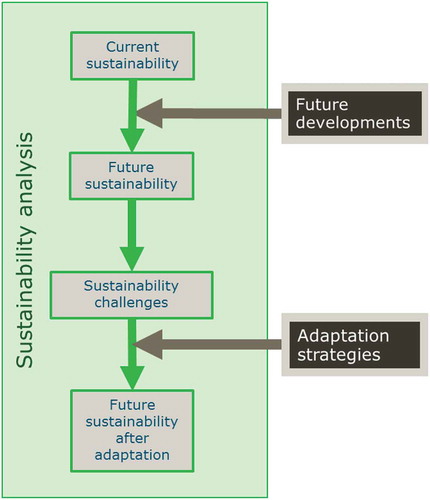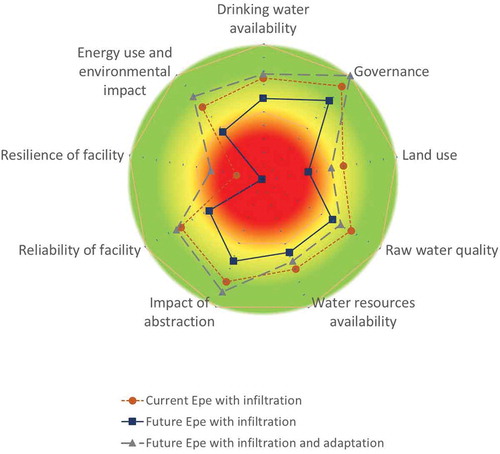ABSTRACT
Globally, groundwater is the major drinking water resource. Improving the sustainability of groundwater abstraction for drinking water calls for adaptation on a local scale. The aim of this research is to develop a locally oriented, integrated sustainability assessment framework to support the adaptation planning process for local drinking water abstractions. The framework uses 45 socio-economic, physical and technical sustainability criteria. Future developments that affect the sustainability of local drinking water abstractions are the increasing water demand, land use change, climate change and soil energy transition. Based on the sustainability challenges of local drinking water abstractions, water saving, protection and restoration of raw water quality, mitigation or reduction of impact of abstraction and improvement of supply security are identified as adaptation strategies. To illustrate the proposed approach the sustainability assessment framework was applied to two local drinking water abstractions in the Netherlands. The paper concludes that the proposed framework provides decision- makers with a transparent understanding of trade-offs that decisions have, and the information generated by the framework supports a careful balancing of relevant aspects playing a role in a decision on adapting local drinking water abstractions. Further development and upscaling of the proposed framework to a drinking water company’s level will contribute to sustainable development of drinking water abstraction on a strategic level.
1. Introduction
Worldwide awareness of the urgency of sustainable development has increased ever since the Brundtland report defined this as the way ‘to ensure that development meets the needs of the present without compromising the ability of future generations to meet their own needs’ (United Nations Citation1987). In 2015 the “2030 Agenda for Sustainable Development” was presented, including Sustainable Development Goal (SDG) 6: to “ensure availability and sustainable management of water and sanitation for all”. Although improvement is visible, the World Health Organization and Unicef (Citation2017) estimated that in 2015 still nearly 30% of the global population lacked safely managed drinking water services. SDG 6 enhances not only access to safe and affordable drinking water for all, but also improvement of water quality, sustainable withdrawal of fresh water and implementation of integrated water resources management (United Nations Citation2015). Globally, groundwater is the major drinking water resource (Ekins et al. Citation2019). Although groundwater is increasingly important for drinking water supply, use of groundwater can be constrained by the complexity and costs of abstraction, or because the resource is polluted or non-renewable, and poor groundwater management may result in pollution or unsustainable abstraction (Ekins et al. Citation2019). In addition, future developments such as climate change and a growing water demand may also threaten the availability of groundwater resources for drinking water supply worldwide.
A drinking water supply system is a heterogeneous technical network of pipelines connecting local drinking water abstraction facilities to the (local) customers. Water infrastructures are known for their complexity, with cross-scale feedbacks between society, technology and environment as well as between the local, regional and global scale (Dermody et al. Citation2018). Because of the long lifecycles of water supply infrastructure, long-term developments require early adaptation (Bauer and Herder Citation2009). Before adaptation options can be selected, the sustainability challenges must be identified, using knowledge on the current situation and future developments (Meijer Citation2007; Pahl-Wostl et al. Citation2007; Swart and Singh Citation2013).
This research focuses on the sustainability of local drinking water abstraction, which is shaped by technical infrastructure, geographical location and the used water resource. Because abstraction facilities are strongly embedded in the local environment and society, there are many stakeholders involved, often with competing interests and affecting the water system in different ways. To enhance the sustainable withdrawal of water, adequate adaptation policies and actions need to be taken.
The first long-term adaptation strategy that must be considered to adapt to an increasing drinking water demand is water saving, which will limit the demand growth (Kumar et al. Citation2016). However, the majority of the current drinking water abstractions will still be needed to meet the future drinking water demand. To identify adaptation options for local abstractions an integrated approach on a local scale is necessary, because of the strong embeddedness of drinking water abstractions in the environment, and the strong spatial and temporal variability in water systems (Hering et al. Citation2015). Therefore, sound data and knowledge of the local situation are required to be able to understand the sustainability challenges such as pollution of the water resources (Janza Citation2015). Each abstraction may face different sustainability challenges caused by local socio-economic, physical or technical characteristics, and thus require specific adaptation strategies. An integrated assessment framework focusing specifically on these local characteristics can support adaptation planning for drinking water abstraction.
The aim of this research, therefore, is “to develop a locally oriented, integrated sustainability assessment framework that supports the adaptation planning process for local drinking water abstraction.”
In this research, we study current practice on adaptation planning of local drinking water abstraction in the Netherlands. The most extreme scenario for the drinking water demand in the Netherlands is an increase of 35% in 2050 (Wolters et al. Citation2018). The drinking water supply will not suffice to meet such an increase and adaptation strategies are considered. Currently approximately 65% of the drinking water supply in the Netherlands origins directly from groundwater, 35% from surface water (Geudens and Van Grootveld Citation2017). The Dutch government puts large effort in sustainable groundwater management (Lijzen et al. Citation2014), but there is also an ongoing societal debate on the need of (partial) transition to direct or indirect use of surface water instead of groundwater for drinking water, which will affect the sustainability of abstractions.
2. Method
Sustainability science is defined by Kates (Citation2016) as: “transdisciplinary research to solve problems of sustainability in practice, combining knowledge and action”. According to Kates (Citation2016), sustainability science must study topics such as long-term trends, resilience, vulnerability and adaptability of society, trade-offs, and alternative pathways to better understand how to increase sustainable development. Transdisciplinary research brings together scientific and experiential knowledge (Regeer and Bunders – Aelen Citation2009), aiming to produce essential information to solve complex problems (Groot et al. Citation2015).
In this research scientific knowledge on sustainability and integrated water management (section 2.1) is combined with current practice on local adaptation planning (section 2.2) to develop an integrated sustainability assessment framework for local drinking water abstraction, based on a conceptual framework on adaptation planning (section 2.3). The proposed sustainability assessment framework is applied to two selected cases (section 2.4).
2.1. Sustainability and integrated water management planning
Loucks (Citation2000) defined sustainable water resources systems as “water resource systems designed and managed to fully contribute to the objectives of society, now and in the future, while maintaining their ecological, environmental, and hydrological integrity.” Although in the last decades, many indicators have been developed for integrated water resources management, they often do not fulfil the commonly used sustainability criteria of social, economic, environmental and institutional components (Pires et al. Citation2017). In addition, for drinking water abstraction the highly technical character of the infrastructure must be considered (Bauer and Herder Citation2009). The sustainability of local drinking water abstraction, therefore, includes socio-economic (combining social, economic and institutional criteria), physical (environmental and hydrological) and technical criteria.
In water management there are multiple approaches available to support adaptation planning, for instance: assessment of the water footprint (Hoekstra Citation2009; Hoekstra et al. Citation2011) or water security (Dickson et al. Citation2016), and decision support by adaptive planning (Haasnoot Citation2013) or multicriteria analysis (Swart and Singh Citation2013). Additionally, many assessments have been developed to understand the sustainability challenges as well as the impact of future developments and adaptation options on different water system components, which are seen as a powerful tool for policy making (Ness et al. Citation2007; Singh et al. Citation2012). The Sustainable Society Index (SSI) (Van der Kerk and Manuel Citation2008), the “EBC Performance Assessment Model” model (European Benchmarking Co-operation Citation2017), the International Water Association (IWA) Performance Indicator System (Alegre et al. Citation2006), the Groundwater Footprint (Gleeson and Wada Citation2013) and the City Blue Print (Van Leeuwen et al. Citation2012) are examples of sustainability assessments that include criteria that are relevant for sustainable drinking water supply systems. This study aims to contribute to the existing body of literature on adaptation planning for sustainable water management on a local scale, by proposing a sustainability assessment framework that is fit for local drinking water abstraction.
2.2. Current practice on local adaptation planning
Vitens is a Dutch drinking water company yearly supplies 350 million m3 drinking water from mainly groundwater resources to approximately 5.6 million people in the Netherlands, produced at 110 local drinking water abstractions (). Vitens made an inventory of the issues that the local drinking water abstractions currently face or may have to face in the future and how to adapt to these issues. The development of this adaptation planning approach was an iterative process supported by an internal expert-panel combining relevant expertise on hydrology and hydrochemistry, drinking water supply and distribution, stakeholder interests, real estate and asset management, communication and investment planning, which was led by the first author of this paper. In the Vitens approach, a sustainable drinking water abstraction facility was defined as a facility that (1) is in good balance with the surrounding land and water system, (2) abstracts a groundwater quality that only requires a simple water treatment method and (3) is accepted and valued positively by stakeholders. The scope of the program was solely on local groundwater withdrawal and therefore excluded the drinking water treatment and distribution.
Figure 1. Drinking water supply area and local drinking water abstractions of drinking water company Vitens in the Netherlands. The assessment framework is applied to the highlighted drinking water abstractions Epe and Vechterweerd (section 4).
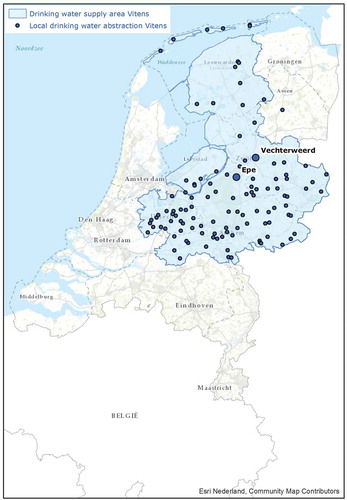
A multi-criteria analysis was used to identify an overall sustainability deficit, and to compose an adaptation agenda for each of the 110 individual local drinking water abstractions. First, the issues and adaptation options (i.e. all possible adaptation measures) to ensure a well-functioning drinking water supply were identified. The sustainability of the abstractions is often debated amongst stakeholders, and therefore a wide range of adaptation options was considered that also satisfied the interests of stakeholders. Not for all sustainability issues, adaptation options were available: for instance, hydrological characteristics cannot be changed by adaptation. Finally, the adaptation agenda for each drinking water abstraction facility was composed, combining the issues with the adequate local adaptation options. The sustainability deficit was appointed as a key performance indicator in the company’s strategic management and therefore was planned to be updated quarterly.
The researcher that was involved in the development process made observations on the constraints Vitens experienced during the operationalization of the adaptation planning approach ().
Table 1. Observed constraints of Vitens approach.
2.3. Conceptual framework
In practice, decision-making in a complex governance environment is a “fuzzy” process that must deal with many uncertainties and calls for involving stakeholders with different interests in the process (De Roo and Porter Citation2016). For analytical purposes, however, we may consider the planning process as a linear sequence of steps (Pahl-Wostl et al. Citation2007, Hinkel, Bisaro et al. Citation2015). Therefore, we propose a linear conceptual framework on adaptation planning (). First, an assessment of the current sustainability is used to identify current sustainability challenges. The impact of future developments as driving forces indicates a possible future sustainability that helps to identify future sustainability challenges. These current and future sustainability challenges are input to identify and appraise local adaptation options that may help to meet these challenges in the future.
We propose to use a Multi-Criteria Analysis (MCA) for the integrated assessment framework. MCA is an integrated assessment tool, often based on a systems analysis approach, and can be used for complex issues and at local scale projects such as local drinking water abstraction (Ness et al. Citation2007). MCA can incorporate both quantitative and qualitative data, has been applied in the environmental domain frequently, and helps to find trade-offs (Huang et al. Citation2011; Swart and Singh Citation2013).
The definition of sustainable local drinking water abstraction is the core of the MCA. We propose a set of socio-economic, physical and technical criteria as a definition of sustainable local drinking water abstraction for the assessment framework, future developments that are relevant for local drinking water abstraction, and adaptation strategies. The proposed set of criteria is combining current practice on local adaptation planning (Section 2.1) with scientific knowledge on sustainable water management that is relevant to local drinking water abstraction (Section 2.2). The criteria are based on available indicators from existing assessments as mentioned (Section 2.1), as well as on policy assessments such as the status of waterbodies according to the European Water Framework Directive (European Union, Citation2000), the Dutch Drinking water Law (Citation2009) and performance data of drinking water utilities (Appendix A).
2.4. Case and data selection
As an illustration, the assessment framework was applied to two abstractions. The researchers chose to apply the framework to Vitens abstractions, because the required data and knowledge were already available. As mentioned in Section 1, in the Netherlands there is a societal debate on (partial) transition of groundwater use towards direct or indirect use of surface water. Decisions on this transition will benefit from understanding the impact of an increasing contribution of surface water to the sustainability of a drinking water abstraction. Therefore, two groundwater abstractions have been selected where surface water is already used to recharge the groundwater system.
The assessment of each criterion requires data on different scales, varying from the local and company’s scale to national scale (). Where possible, quantitative, publicly available data are used. Local operational data of drinking water companies are usually not publicly available, and data on stakeholders interests are qualitative.
Table 2. Overview of used data.
3. Proposed assessment framework
The conceptual framework is used to design the integrated assessment framework ().
Figure 3. Integrated assessment framework for adaptation planning on sustainable local drinking water abstraction.
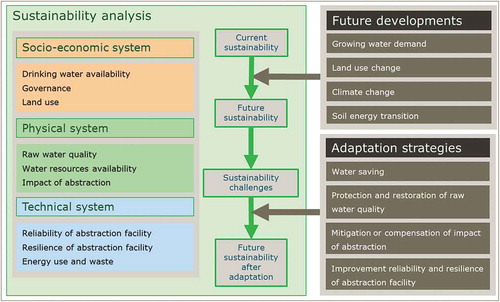
First current sustainability is assessed, followed by identification of future sustainability based on the estimated long-term (>25 years) impact of relevant future developments. Then, adaptation strategies are identified and the impact of these strategies to the future sustainability of the local drinking water abstraction is estimated, in order to identify the future sustainability after adaptation.
3.1. Sustainable local drinking water abstraction
The concept of sustainable local drinking water abstraction is expressed in socio-economic (combining social, economic and institutional criteria), physical (environmental and hydrological) and technical sustainability criteria ().
Figure 4. Categories, criteria and output spider diagram of the integrated assessment framework. The outer border of the green area represents the maximum sustainability score. A category that scores within the red centre area (<50% of maximum sustainability) represents a sustainability challenge.
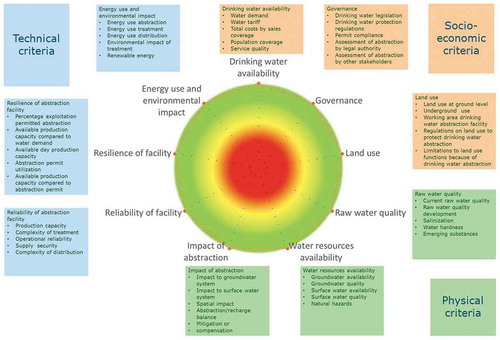
Each criterion is initially assessed and categorized in “sustainable” via “under pressure” to “unsustainable” (Appendix A). Because the use of weights per criterion in the Vitens approach was robust (), a comparable weighting of the criteria within each category is used. To ensure trade-offs between different categories are visualized, a spider diagram is used to present the results of the assessment, thereby also avoiding the need to assign weights per category, which was a constraint in the Vitens approach. The scale is a gradient, where the red centre represents “unsustainable”, the green outer circle “sustainable” and the yellow area in between shows that the sustainability is “under pressure” (). When a category is entering the red centre this is considered to be a sustainability challenge.
3.2. Future developments
Future developments that influence water demand, water quality, or environmental impact cause the main future sustainability challenges for local drinking water abstractions.
Currently, the global water demand is still growing (Hanasaki et al. Citation2013). In the Netherlands, a maximum increase of drinking water demand of 30% in 2040 may occur (Van der Aa et al. Citation2015). This will put the current drinking water supply under pressure. In this research, we assume that the volume of abstracted water at a local drinking water abstraction will increase as a result of the growing water demand.
Land use change such as urbanization, extension and/or intensification of agricultural use, and increase of industrial areas affects the water system (Brink and Wuijts Citation2016), both water quality and quantity (Lerner and Harris Citation2009), and therefore is a relevant future development for local drinking water abstraction (Van Rijswick and Wuijts Citation2016). In this research, we assume that land use change will have an increasing, negative impact to the water system, which can be expected given the current economic development (Klijn et al. Citation2012).
Climate change is an important future development that will affect the water system and thus the drinking water supply (Staben et al. Citation2015). In the Dutch situation already more warm, dry summers and wet winters occur, and this is expected to increase (Van Den Hurk et al. Citation2014). Lower precipitation and higher evapotranspiration rates will cause a diminishing water availability and recharge to the water system in summer, and a deteriorating surface water quality during summer (Bonte and Zwolsman Citation2010). This may eventually lead to groundwater quality deterioration too through the infiltration of surface water. The requirements for water treatment will therefore also change as a result from climate change (Staben et al. Citation2015). In this research, we assume that climate change will reduce water availability as well as deteriorate water quality.
Next to transition to wind and solar energy, the current transition from fossil-based energy to renewable energy may also include the development of projects for geothermal and other forms of soil energy. This development may have an impact to groundwater quality through thermal changes (Bonte et al. Citation2013), and through the introduction of pollution risks from calamities or negligent use, and thus may threaten drinking water abstraction. In some countries, there are legal limitations on where soil energy is allowed to avoid irreversible damage to drinking water resources (Haehnlein et al. Citation2010). However, policies may change with the increasing urge to find sufficient sources of renewable energy and thus interference between soil energy and drinking water abstraction may increase. In this research, we consider soil energy transition a relevant future development with a long-term negative impact to groundwater quality.
The selected future developments will affect multiple sustainability criteria in different ways (). For instance, a changing water quality as a result of land use change or climate change may affect the raw water quality, which will have an impact to the complexity and energy use of the treatment. An increasing abstracted water volume as a result of growing water demand may affect the reliability, i.e. the likeliness of the technical system to fail (Hashimoto et al. Citation1982), and resilience, i.e. the possibility to recover from failure or to respond to changes (ibid) of the facility, but will also increase the recharge area of the local drinking water abstraction and this may affect the water quality. The factual impact of future developments depends strongly on the local situation. If the land use in the recharge area is mainly nature, it is unlikely that land use change or soil energy transition will affect the local drinking water abstraction strongly, whereas in an urbanized recharge area this will be a serious threat. Assessing the impact of the future developments to a specific local drinking water abstraction thus requires local expert-knowledge.
Table 3. Impact of future developments and adaptation strategies to sustainability criteria in the integrated assessment framework for sustainable local drinking water abstraction.
Table 4. Projected main impact of local adaptation options of drinking water abstractions Epe and Vechterweerd, both situated in the Netherlands.
3.3. Adaptation strategies
Based on the sustainability criteria, future developments and current practice, four adaptation strategies have been identified: water saving, protection and restoration of raw water quality, mitigation or reduction of impact of abstraction, and improvement of supply security. Every adaptation strategy must be elaborated into local adaptation options, which may affect sustainability criteria in different ways, depending on the local situation. To assess the projected impact of each adaptation strategy to a specific local drinking water abstraction, the effects of each individual adaptation option must be rated. Adaptation options can be one-time or permanent measures with a stepwise or gradual, and medium- or long-term impact to different sustainability criteria: for instance the technical realization of managed aquifer recharge or managed water supply as a mitigation option may reduce the impact of a local drinking water abstraction directly, but the long-term exploitation of these measures will affect energy use permanently and the raw water quality gradually.
Water saving is a long-running adaptation strategy that will affect the water demand in general. The expected water demand growth is yet already an incentive for water-saving strategies to reduce the use of drinking water. Possible adaptation options are raising consumers awareness on the need of water saving, technical innovations that reduce consumer or industrial water use, use of new water resources such as wastewater or rainwater, regulations to enforce water saving or increasing consumer or industrial water prices. This adaptation strategy will become gradually visible in the long term in a decreasing water demand, and thus will impact the reliability and resilience of the local drinking water abstraction in the long term.
There are many adaptation options to protect or restore the water resources quality for drinking water. Options are joint monitoring of water quality and raising awareness of the importance of water quality protection among regional and local stakeholders, prevention of water pollution resulting from calamities, but also initiating measures to improve the protection of water quality by reduction of the impact of agriculture, built-up area or point sources of pollution to water quality. Environmental legislation and regulations, and their enforcement is a precondition for protection and restoration. Adaptation options to protect or restore water quality focus on influencing land use and remediation of pollution, and therefore require adequate policies to effectively influence surface runoff and leakage to groundwater (Lerner and Harris Citation2009). Influencing water quality through land use change is a long-term process and the effects are only noticeable in the long term, especially when considering groundwater quality improvement, which is a very slow process. Measures must be taken in a large area to improve water quality and thus ask for cooperation with local stakeholders such as farmers, industries and municipalities. This adaptation strategy will therefore not solve all water quality problems, but will help to prevent further deterioration.
The adaptation options to mitigate or compensate the impact of a specific local drinking water abstraction to nature values, agriculture or buildings depend on the local situation. It requires an integrated stakeholder process to find out which option is effective and feasible in this specific local situation. The actual design and construction of the selected measure to mitigate the environmental impact of this local drinking water abstraction is following the stakeholder process. The mitigation measure may impact some sustainability criteria adversely. For instance, managed aquifer recharge will improve the sustainability of the category “impact of abstraction”, but may reduce the sustainability in the categories “water resources availability” and “energy use and environmental impact”. Compensation of the impact may be financial or measures elsewhere, and thus will not reduce the impact of an abstraction. However, it may contribute to a positive assessment by stakeholders and legal authorities.
The reliability and resilience of a local drinking water abstraction can be improved by technical measures such as optimization of operational management, treatment or distribution within the existing permit capacity, or by extension of the permit capacity. Acquiring a new or extended permit is a complex and time-consuming process, involving legal procedures and local stakeholder processes. Whether and under which conditions extension is possible depends on the local situation.
4. Application in two adaptation practice cases
The framework is applied to assess the sustainability of two Vitens drinking water abstractions in the Netherlands: the Epe drinking water abstraction and the Vechterweerd drinking water abstraction ().
4.1. Sustainability assessment of the Epe drinking water abstraction, the Netherlands
4.1.1. General description
The Epe drinking water abstraction () is abstracting phreatic fresh groundwater of good quality and low hardness. The land use in the recharge area is mainly protected forest. A simple water treatment is used, to remove iron and manganese and to correct the pH-level. Day production capacity is insufficient in high demand situations and the distribution is complex. To reduce the impact of the abstraction to the groundwater system and nearby nature values, an infiltration through Managed Aquifer Recharge (MAR) was constructed, where untreated surface water is infiltrated near the abstraction wells. This infiltration has introduced a new risk for the groundwater quality through the impact of surface water quality and land use in the upstream area. When there is a quality disturbance or insufficient surface water availability, infiltration is put on hold. The abstraction permit is 6 million m3/yr, but there are limitations in the production capacity. There is a separate permit for infiltration of 6 million m3/yr, which is linked to the abstraction permit. Because of technical problems and insufficient surface water availability the infiltration volume is currently limited, and to meet the permit requirements the drinking water abstraction volume must be reduced.
4.1.2. Sustainability assessment
The current sustainability challenge for the drinking water abstraction Epe is the resilience of the facility (), which is partially caused by technical limitations in the production capacity. The resilience is also under pressure because of the infiltration permit conditions, that reduce the permitted production volume when the infiltration volume falls short.
Figure 5. Results local drinking water abstraction Epe, the Netherlands: (a) Current sustainability with (brown) and without (light blue) mitigation by infiltration and (b) Future sustainability with (dark blue) and without (brown) mitigation by infiltration. The outer border of the green area represents the maximum sustainability score. A category that scores within the red centre area (<50% of maximum sustainability) represents a sustainability challenge.

The future developments will put the categories “water resources availability” and “land use” under pressure, mainly because of the infiltration of untreated surface water. An increase in the water demand will affect not only the required production volume of drinking water but also the required infiltration volume. Land use change and climate change are projected to cause deterioration of the surface water quality and therefore will influence the raw water quality and the availability of the water resources.
The assessment shows that the infiltration system to mitigate the impact of the abstraction to the groundwater system has a large effect on the current as well as future sustainability of the drinking water abstraction Epe. Comparing the sustainability of this abstraction with infiltration to a situation without infiltration identifies clearly the trade-offs of the decision to construct this infiltration system (): without infiltration the impact of the abstraction would not be mitigated, which would also put the acceptance of the abstraction by the legal authority and by stakeholders (category governance) under pressure. However, the abstraction would not be influenced by surface water and land use in the recharge area, the water resources would be less vulnerable and the raw water quality would not be under pressure. Also, the resilience of the facility would improve because the abstraction volume would not be limited by the actual infiltration volume.
4.1.3. Local adaptation options
To meet the sustainability challenges of drinking water abstraction Epe four local adaptation options are selected (). Water saving is a general option to limit the water demand growth, which will improve the resilience of the facility (). Protection of the surface water quality will influence the water quality for the infiltration in the long term to help safeguard the raw water quality of the abstraction (). Optimization of the infiltration to increase the infiltration volume will solve the limitation to the abstraction volume and further reduce the impact of the abstraction to the groundwater system (). Construction of new production capacity by adding abstraction wells and extra treatment capacity will improve the resilience as well as the reliability of the facility ().
Figure 6. Long- term impact of the selected local adaptation options (a) Water saving, (b) Protection surface water quality, (c) Optimization infiltration, (d) New production capacity to the future sustainability of the Epe drinking water abstraction, the Netherlands. The outer border of the green area represents the maximum sustainability score. A category that scores within the red centre area (<50% of maximum sustainability) represents a sustainability challenge.
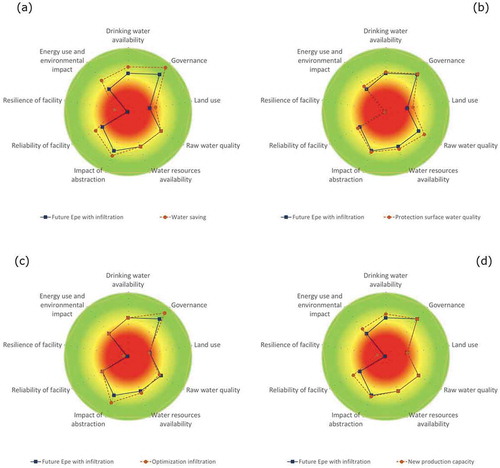
4.1.4. Future sustainability with adaptation
The future sustainability of the Epe drinking water abstraction will improve by the total impact of the four selected adaptation options. However, the sustainability in the categories “land use”, “raw water quality” and “water resources availability” is assessed lower than in the current situation (). Protection and restoration of raw water quality will not solve all water quality problems, but will help to prevent further deterioration. Although important, the impact of this adaptation strategy to the sustainability is limited and will not compensate for the impact of the future developments to the raw water quality. This also influences the categories “land use” and “water resources availability”.
4.2. Sustainability assessment of drinking water abstraction Vechterweerd, the Netherlands
4.2.1. General description
Drinking water abstraction Vechterweerd () is a so-called “riverbank” abstraction with groundwater wells that are abstracting a mixture of 40% groundwater and 60% recently infiltrated surface water. As a result of the large contribution of surface water, the raw water quality is also vulnerable to changes in the surface water system, for instance, caused by calamities and climate change. Because of the uncertain raw water quality, there is a complex water treatment using activated carbon, membrane filtration and UV, and a comprehensive monitoring program for ground- and surface water quality. The abstraction permit is 8 million m3/year, the current production capacity is sufficient for 2 million m3/yr. Because of the increasing water demand and limited availability of drinking water abstraction permits in the area, the legal authority has given Vitens the assignment to evaluate the possibilities of extension of the production capacity of drinking water abstraction Vechterweerd within the current permit.
4.2.2. Sustainability assessment
The current sustainability challenges for drinking water abstraction Vechterweerd, the Netherlands, are raw water quality, water resources availability, and energy use and environmental impact (). In the future, the reliability of the facility and land use may become sustainability challenges. These challenges are mainly caused by the impact of the large contribution of surface water to the raw water and the complex water treatment that is required to meet the drinking water standards.
Figure 8. Results Vechterweerd drinking water abstraction, the Netherlands: Current (blue) and Future sustainability (brown) of (a) the present production capacity of 2 million m3/year and (b) an extended production capacity of 6 million m3/year. The outer border of the green area represents the maximum sustainability score. A category that scores within the red centre area (<50% of maximum sustainability) represents a sustainability challenge.
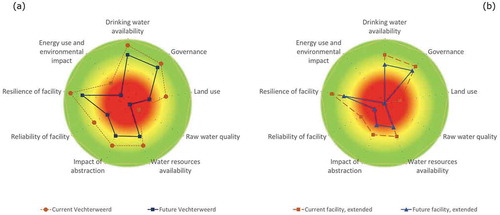
To evaluate the impact of extension of the Vechterweerd drinking water abstraction to meet current and future water demand, we compared the actual situation with 2 million m3/year production capacity with a situation with 6 million m3/year production capacity (). The results show that the current and future sustainability challenges will increase further because the impact of the surface water quality will increase and the complex treatment must triple, with a large increase in energy use and environmental impact. The future developments will enlarge this impact and thus the sustainability of the extended Vechterweerd drinking water abstraction will deteriorate further in the future.
4.2.3. Local adaptation options
To meet the sustainability challenges of the Vechterweerd drinking water abstraction two adaptation strategies are relevant: water saving and protection or restoration of raw water quality (). Water saving is a general option to limit the water demand growth, which will improve the sustainability of the abstraction for most categories (). The selected local adaptation options are protection of the surface water quality, protection of the groundwater quality and improvement of the groundwater protection zone. These measures will not solve all water quality problems, but will help to prevent further deterioration. Because of the large contribution of surface water to the raw water quality, the combined impact of these measures to the sustainability challenges is small ().
Figure 9. Long- term impact of the selected local adaptation options (brown): (a) Water saving, (b) Protection/restoration water quality compared to future sustainability (dark blue) of the Vechterweerd drinking water abstraction, the Netherlands. The outer border of the green area represents the maximum sustainability score. A category that scores within the red centre area (<50% of maximum sustainability) represents a sustainability challenge.
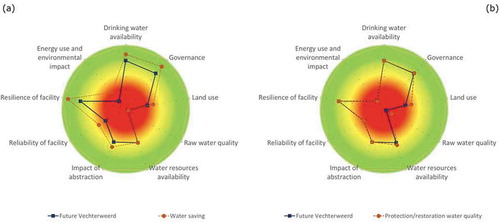
4.2.4. Future sustainability with adaptation
The only available local adaptation options for the Vechterweerd drinking water abstraction – next to water saving – are measures to protect and restore raw water quality. As explained in section 3.3, the positive impact of these measures is limited, but they may prevent further deterioration of the raw water quality. While the future developments will negatively affect the surface and groundwater quality near the Vechterweerd drinking water abstraction, these adaptation options will fully not compensate for the future developments (). As a result, the future sustainability will only slightly improve by the local adaptation options and will be less than the current sustainability.
Figure 10. Current sustainability (brown), future sustainability (dark blue) and future sustainability after adaptation with the selected local adaptation options (grey) of the Vechterweerd drinking water abstraction, the Netherlands. The outer border of the green area represents the maximum sustainability score. A category that scores within the red centre area (<50% of maximum sustainability) represents a sustainability challenge.
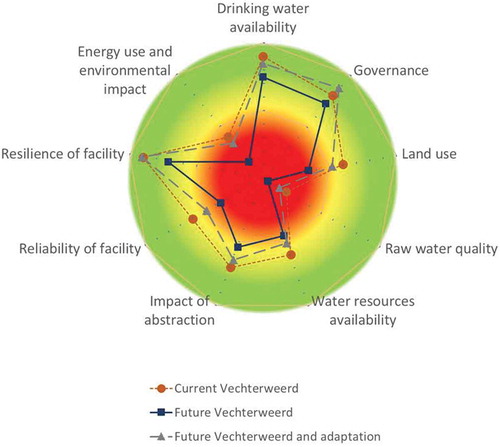
5. Discussion
The discussion focuses on the sustainability assessment (section 5.1), the results of the case studies (section 5.2), the importance of stakeholder involvement (section 5.3) and the usability of the framework (section 5.4).
5.1. Sustainability assessment
In the integrated sustainability assessment framework a local drinking water abstraction was valued sustainable when achieving maximal scores in all categories. It is however unlikely that any local drinking water abstraction will be assessed fully sustainable at any moment in the future, because of trade-offs between criteria, and invariability of some physical criteria. The aim of adaptation is to improve the sustainability by sustainable development. While in general the direction of the impact of future developments and adaptation options can be indicated in terms of negative, positive or neutral, the extent of the impact is less distinct. Considering this, and knowing that there is no standard unit to measure sustainability, the researchers chose to use a gradual colour scheme rather than a numerical scale to present the results of the sustainability assessment. The results thus compare current and future sustainability, providing insight into the development of sustainability challenges of the local drinking water abstraction.
Stakeholders may have different views on how to define sustainable local drinking water abstraction. For instance, nature preservation organizations measure the sustainability by the impact of an abstraction to valuable nature, whereas households may value “safe and continuous drinking water supply” sustainable. The used criteria are defined as measurable as possible (Appendix A). In the Sustainable Society Index, indicators are only used if they are measurable and if the required data are available (Van der Kerk et al. Citation2014). However, to ensure the full scope of sustainable drinking water abstraction, the authors chose to include all relevant criteria, including criteria that can only be qualitatively valued.
5.2. Case studies
In this research, the sustainability assessment framework was applied to the Epe and Vechterweerd drinking water abstractions in the Netherlands. In the case of drinking water abstraction Epe, mitigation of the impact was obligatory following legislation and regulations on nature protection, but a better understanding of the impact and trade-offs of the infiltration to the sustainability of this abstraction might have led to additional measures to energy use reduction or surface water protection. An extension of the production capacity of Vechterweerd will reduce the sustainability of this drinking water abstraction. However, this may be an adaptation option that will help to improve the overall sustainability of drinking water abstraction in a larger area, when this option is used to replace a connected abstraction facility which is assessed less sustainable. In general, the results of the two cases show that all adaptation strategies require stakeholder involvement that they may not be sufficient to compensate for the long-term impact of the future developments to local drinking water abstractions, and that compensating the impact of groundwater abstraction by a transition towards surface water may cause trade-offs. Upscaling the assessment to a regional scale by including nearby interconnected local drinking water abstractions will support finding a sustainable adaptation strategy in a certain region.
5.3. Stakeholder involvement
Because local drinking water abstractions are strongly embedded in the environment, stakeholder involvement is essential in the adaptation planning process. In the planning process of the Epe mitigation and the Vechterweerd abstraction, the drinking water company worked closely together with local stakeholders such as governmental agencies and local interest groups. Although the drinking water company can initiate the adaptation strategies on mitigation or compensation of the impact, and improvement of the reliability or resilience of the abstraction, these strategies include legal procedures and will require stakeholder involvement. Adaptation strategies on water saving require commitment and co-operation from all stakeholders on national and regional level, as well as from local households, which makes the effectiveness of the strategy uncertain. The adaptation strategy protection and restoration of raw water quality are a valuable strategy, but also requires a collective effort from multiple stakeholders.
5.4. Usability of the framework
The proposed sustainability assessment framework is downscaling targets from Sustainable Development Goals 6 (United Nations Citation2015) to a local level. It integrates the outcome of different types of models, such as hydrological and drinking water infrastructure models, rather than guiding new model development. Globally groundwater is the major drinking water resource, and aquifers are often under pressure. Improving the sustainability of local drinking water abstraction, therefore, is a challenge for drinking water companies and governments worldwide. The framework can be used under conditions where there are conflicting interests between the local drinking water abstraction, the water system and/or land use, in Europe as well as in other parts of the world. Data availability is a precondition to use the sustainability assessment framework, but the framework can also be used to identify knowledge gaps on the sustainability of an abstraction. The strong focus of the proposed framework to the local level limits the possibilities to directly upscale the results to a national or global level, but the assessment framework can be developed further to a higher aggregation level by for instance accumulating local results to an area or drinking water company’s level or by defining composite criteria.
In the assessment framework economic aspects are taken into account in criteria such as the water tariff and the energy use. The investment costs of the adaptation options, however, are not part of the assessment. The decision-making process is complex and takes into account costs, legislation and regulations as well as stakeholder interests and opinions. The proposed sustainability assessment framework is a valuable tool that contributes sustainability knowledge to this process.
6. Conclusion and recommendations
In this research, a locally oriented, integrated sustainability assessment framework that supports the adaptation planning process for local drinking water abstractions was developed.
The research brings together scientific and experiential knowledge on sustainable drinking water abstraction, following the transdisciplinary approach of sustainability science as defined by Kates (2016) and Regeer and Bunders – Aelen (Citation2009). Using the sustainability assessment framework together with the stakeholders will help to integrate scientific and stakeholders knowledge and interests. Additionally, it will provide stakeholders with an overview of the sustainability challenges, the impact of adaptation options and their trade-offs for the stakeholder interests as well as for the drinking water supply interests.
Based on the results of the illustrative application to the cases, we conclude that the proposed framework provides decision-makers with a transparent understanding of trade-offs that decisions have, and the information generated by the framework supports a careful balancing of relevant aspects playing a role in a decision on adapting local drinking water abstractions.
A broad perspective was sought in order to include different interests of stakeholders, and to enhance the transferability of the sustainability assessment framework. A recommendation is to test and further develop the framework, for instance by comparing the sustainability of groundwater or surface water use. Further development and upscaling of the proposed framework to a drinking water company’s level or to a national level will contribute to the sustainable development of drinking water abstraction on a strategic level.
Data availability statement
The authors confirm that the results of the assessment of the Epe and Vechterweerd drinking water abstractions are available within the supplementary materials. We invite researchers that are interested to use the assessment framework to contact the corresponding author (JvE) for support.
Disclosure statement
No potential conflict of interest was reported by the authors.
References
- Alegre H, Baptista JM, Cabrera E Jr, Cubillo F, Duarte P, Hirner W, Merkel W, Parena R. 2006. Performance indicators for water supply services. London: IWA Publishing.
- Bauer JM, Herder PM. 2009. Designing socio-technical systems. Philosophy of technology and engineering sciences. Amsterdam, Netherlands: Elsevier; p. 601–630.
- Bonte M, van Breukelen BM, Stuyfzand PJ. 2013. Temperature-induced impacts on groundwater quality and arsenic mobility in anoxic aquifer sediments used for both drinking water and shallow geothermal energy production. Water Res. 47(14):5088–5100.
- Bonte M, Zwolsman JJ. 2010. Climate change induced salinisation of artificial lakes in the Netherlands and consequences for drinking water production. Water Res. 44(15):4411–4424.
- Brink CVD, Wuijts S. 2016. Towards an effective protection of groundwater resources: putting policy into practice with the drinking water protection file. Water Policy. 18(3):635–653.
- De Roo G, Porter G. 2016. Fuzzy planning: the role of actors in a fuzzy governance environment. Abingdon, UK: Routledge.
- Dermody BJ, Sivapalan M, Stehfest E, van Vuuren DP, Wassen MJ, Bierkens MFP, Dekker SC. 2018. A framework for modelling the complexities of food and water security under globalisation. Earth Syst Dyn. 9(1):103–118.
- Dickson SE, Schuster-Wallace CJ, Newton JJ. 2016. Water security assessment indicators: the rural context. Water Resour Manag. 30(5):1567–1604.
- Dutch Government, Drinking Water Law. 2009. [assessed 2019 Jun 30]. https://wetten.overheid.nl/BWBR0026338/2015-07-01.
- Ekins P, Gupta J, Boileau P. 2019. Global Environment Outlook GEO-6: healthy planet, healthy people. Global Environment Outlook. Cambridge: United Nations Environment Programme. 6.
- EU. 2000. Water Framework Directive. Directive 2000/60/EC of the European Parliament and of the Council C.F.R.
- European Benchmarking Co-operation. 2017. Learning from international best practices; 2017 water and wastewater benchmark. The Hague (Netherlands): EBC.
- Geudens PJJG, Van Grootveld J. 2017. Drinkwaterstatistieken 2017. The Hague, Netherlands: VEWIN; p. 130.
- Gleeson T, Wada Y. 2013. Assessing regional groundwater stress for nations using multiple data sources with the groundwater footprint. Environ Res Lett. 8(4):9.
- Groot AME, Bosch PR, Buijs S, Jacobs CMJ, Moors EJ. 2015. Integration in urban climate adaptation: lessons from Rotterdam on integration between scientific disciplines and integration between scientific and stakeholder knowledge. Build Environ. 83:177–188.
- Haasnoot M. 2013. Anticipating change; sustainable water policy pathways for an uncertain future. Enschede, Netherlands: Universiteit Twente.
- Haehnlein S, Bayer P, Blum P. 2010. International legal status of the use of shallow geothermal energy. Renewable Sustainable Energy Rev. 14:2611–2625.
- Hanasaki N, Fujimori S, Yamamoto T, Yoshikawa S, Masaki Y, Hijioka Y, Kainuma M, Kanamori Y, Masui T, Takahashi K, et al. 2013. A global water scarcity assessment under shared socio-economic pathways – part 1: water use. Hydrol Earth Syst Sci. 17(7):2375–2391.
- Hashimoto T, Stedinger JR, Loucks DP. 1982. Reliability, resiliency, and vulnerability criteria for water resource system performance evaluation. Water Resour Res. 18(1):7.
- Hering JG, Sedlak DL, Tortajada C, Biswas AK, Niwagaba C, Breu T. 2015. Local perspectives on water. Science. 349(6247):2.
- Hinkel J, Bisaro A, Swart R. 2015. Towards a diagnostic adaptation science. Regional Environmental Change. 16(1):1-5. doi:10.1007/s10113-015-0850-x.
- Hoekstra AY. 2009. Human appropriation of natural capital: A comparison of ecological footprint and water footprint analysis. Ecol Econom. 68(7):1963–1974.
- Hoekstra AY, Chapagain AK, Aldaya MM, Mekonnen MM. 2011. The water footprint assessment manual; setting the global standard. Abingdon, UK: Routledge.
- Huang IB, Keisler J, Linkov I. 2011. Multi-criteria decision analysis in environmental sciences: ten years of applications and trends. Sci Total Environ. 409(19):3578–3594.
- Janza M. 2015. A decision support system for emergency response to groundwater resource pollution in an urban area (Ljubljana, Slovenia). Environ Earth Sci. 73(7):3763–3774.
- Kates RW. 2016. Sustainability Science. In Richardson NCD, Goodchild MF, Kobayashi A, Liu W, and Marston RA, editor(s). International encyclopedia of geography: people, the earch, environment and technology. Hoboken: John Wiley & Sons, Ltd; p. 1-4.
- Klijn F, Van Velzen E, Ter Maat J, Hunink J. 2012. Zoetwatervoorziening in Nederland; aangescherpte landelijke knelpuntenanalyse 21e eeuw.
- Kumar V, Del Vasto-Terrientes L, Valls A, Schuhmacher M. 2016. Adaptation strategies for water supply management in a drought prone Mediterranean river basin: application of outranking method. Sci Total Environ. 540:344–357.
- Lerner DN, Harris B. 2009. The relationship between land use and groundwater resources and quality. Land Use Policy. 26:S265–S273.
- Lijzen JP, Otte P, Van Dreumel M. 2014. Towards sustainable management of groundwater: policy developments in the Netherlands. Sci Total Environ. 485–486:804–809.
- Loucks DP. 2000. Sustainable water resources management. Water Int. 25(1):3–10.
- Meijer HM. 2007. Intertwining uncertainty analysis and decision-making about drinking water infrastructure. Delft: Delft University of Technology.
- Ness B, Urbel-Piirsalu E, Anderberg S, Olsson L. 2007. Categorising tools for sustainability assessment. Ecol Econom. 60(3):498–508.
- Pahl-Wostl C, Sendzimir J, Jeffrey P, Aerts JCJH, Berkamp G, Cross K. 2007. Managing change toward adaptive water management through social learning. Ecol Soc. 12(2):30.
- Pires A, Morato J, Peixoto H, Botero V, Zuluaga L, Figueroa A. 2017. Sustainability Assessment of indicators for integrated water resources management. Sci Total Environ. 578:139–147.
- Regeer BJ, Bunders - Aelen JGF. 2009. Knowledge co-creation: interaction between science and society. A transdisciplinary approach to complex societal issues. The Hague, Netherlands: RMNO/COS.
- Singh RK, Murty HR, Gupta SK, Dikshit AK. 2012. An overview of sustainability assessment methodologies. Ecol Indic. 15(1):281–299.
- Staben N, Nahrstedt A, Merkel W. 2015. Securing safe drinking water supply under climate change conditions. Water Sci Technol: Water Supply, IWA Publishing. 15:1334–1342.
- Swart RJ, Singh T. 2013. MEDIATION and the Adaptation Challenge: identifying appropriate methods and tools to support climate change adaptation decision making. MEDIATION project. Wageningen: Alterra, Wageningen UR.
- United Nations. 1987. Our common future: report of the World Commission on Environment and Development. Geneva.
- United Nations. 2015. Transforming our world: The 2030 Agenda for Sustainable Development; A/RES/70/1.
- Van Den Hurk B, Siegmund P, Klein Tank A. 2014. KNMI’14: climate change scenarios for the 21st Century – A Netherlands perspective. Scientific Report. De Bilt (the Netherlands): KNMI; p.115.
- Van der Aa M, Tangena B, Wuijts S, De Nijs T. 2015 augustus 26. Voldoende grondwater voor de drinkwatervoorziening in 2040? H2O-online.
- Van der Kerk G, Manuel A. 2008. A comprehensive index for a sustainable society: the SSI — the sustainable society index. Ecol Econom. 66(2–3):228–242.
- Van der Kerk G, Manuel A, Kleinjans R. 2014. Sustainable Society Index SSI-2014. The Hague (the Netherlands): Sustainable Society Foundation.
- Van Leeuwen CJ, Frijns J, Van Wezel A, Van de Ven FHM. 2012. City blueprints: 24 indicators to assess the sustainability of the urban water cycle. Water Resour Manag. 26(8):2177–2197.
- Van Rijswick H, Wuijts S. 2016. Sustainable river basin management under the European water framework directive: an effective protection of drinking-water resources.In Watershed and River Basin Management. Budapest: Trivent.
- Wolters HA, Van Den Born GJ, Dammers E, Reinhard S. 2018. Deltascenario’s voor de 21e eeuw, actualisering 2017. Utrecht: Deltares.
- World Health Organization (WHO) and United Nations Children's Fund (UNICEF). 2017. Progress on drinking water, sanitation and hygiene: 2017 update and SDG baselines. Geneva. Licence: CC BY-NC-SA 3.0 IGO.
Appendix A.
Integrated sustainability assessment framework
Table A1. Categories and criteria used in the integrated assessment framework: categories and criteria, general definition, and classification of sustainable, under pressure and unsustainable.
Table A2. Used data for cases of Epe and Vechterweerd, and suggestions for general data sources.
Table A3. Layout and working procedure excel worksheet (see supplementary material).

